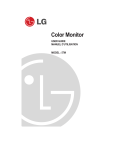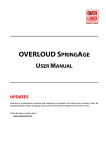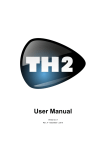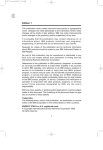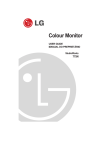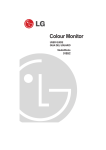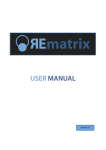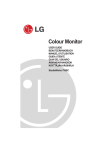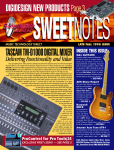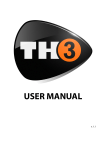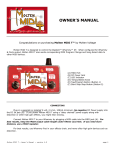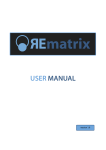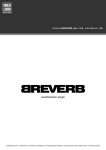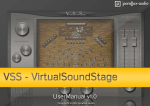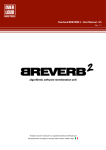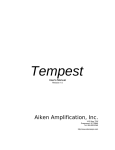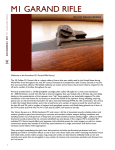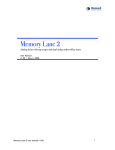Download Version 1.1.2 Rev. A – March 6, 2009 Rev. B – April 30, 2009
Transcript
Version 1.1.2 Rev. A – March 6, 2009 Rev. B – April 30, 2009 TH1 Triode Manual Contents Contents ................................................................................................................................................................................................................................... 2 Important Note ........................................................................................................................................................................................................................ 4 User Interface ........................................................................................................................................................................................................................... 5 HEADER PANEL 5 SOUND PANEL 5 OVERVIEW PANEL 6 MODULE VIEW PANEL 6 SMART PANEL 6 FOOTER PANEL 6 FREELY RESIZABLE WINDOW 7 AUTO-HIDE THE OVERVIEW PANEL 7 Playing with TH1 ...................................................................................................................................................................................................................... 8 Connecting the Guitar 8 TH1 Standalone Options 8 Input Channel Choice in TH1 8 Input Level Adjustment 9 Banks, Sound, Variations 9 Live Mode ................................................................................................................................................................................................................................. 9 Compact Live Mode ................................................................................................................................................................................................................. 9 Editing TH1 ............................................................................................................................................................................................................................. 11 The Sound Chain and the Module Panel 11 TH1 signal flow explained 11 TH1 Mixer Module 11 Interacting with Modules 11 Module Presets 13 TH1 Memory - Basic Concepts............................................................................................................................................................................................... 15 User and Factory memory locations 15 What is a Bank? 15 What is a Sound? 15 What is a Variation? 15 Naming memories 15 Basic browsing 15 When to write to disk 15 Writing to disk – Basic method 15 Copy and Paste of memories 16 Clearing memories 16 Reverting to a saved memory 16 TH1 Memory – Advanced Concepts ..................................................................................................................................................................................... 17 Sound Browser panel 17 Right-click operations in Browser 18 Import and Export Bank 18 Taking control locally............................................................................................................................................................................................................. 19 Smart Controls 19 Taking control via Host Automation .................................................................................................................................................................................... 22 Automatable Parameters Table 22 Taking control via MIDI – MIDI Bindings .............................................................................................................................................................................. 23 MIDI Bindings Preset menu 23 Program Change recalls internal memory 23 Overloud™ is a trademark of Almateq srl • All Specifications subject to change without notice Made in Italy • www.overloud.com 2 TH1 Triode Manual How to program MIDI events to control TH1 23 Cosmetics................................................................................................................................................................................................................................ 25 TH1 Floor management 25 Interface Preferences ............................................................................................................................................................................................................. 26 Advanced usage of TH1 ......................................................................................................................................................................................................... 27 The Amplifier Module 27 The Cabinet Module 27 BPM Modes 28 Technical Support .................................................................................................................................................................................................................. 30 FAQ – Frequently Asked Questions 30 Free Technical Support 30 End User License Agreement ................................................................................................................................................................................................ 31 Overloud™ is a trademark of Almateq srl • All Specifications subject to change without notice Made in Italy • www.overloud.com 3 TH1 Triode Manual Important Note All product names and trademarks are property of their respective owners, which are in no way associated or affiliated with Overloud. These product names and trademarks of other manufacturers are used solely for the purpose of identifying the specific products that were studied during Overloud's sound model development and for describing certain types of tones produced by Overloud‟s digital modeling technologies. The use of these names and trademarks does not imply any cooperation or endorsement. Overloud™ is a trademark of Almateq srl • All Specifications subject to change without notice Made in Italy • www.overloud.com 4 TH1 Triode Manual User Interface The TH1 interface is split into six stacked horizontal panels: Header, Sound, Overview, Module, Smart and Footer. Each of these panels is dedicated to particular functionalities of TH1. Let's take a look. HEADER PANEL The Header panel features the global controls of TH1, with the input-related ones on the left side while the output-related ones are located at the right end. Fig 1 - Header Panel LIVE IN LEV IN TUNER OUT OUT Toggles between normal and Live Mode (no prompts to save when changing tone) Shows the Input Level Adjustment window which helps in setting the optimal input level Input level meter TH1 Tuner; press ON to turn it on, MUTE to temporarily silence TH1 output Output level knob: adjusts TH1 output level Output level meter By clicking OPEN in the Tuner zone, the lid opens up giving you access to TH1 Global controls. Global controls act as an overall “Master” control that affects TH1 sound regardless of the Variation being loaded. Fig 2 - Header Panel with Master controls made visible INPUT GATE LOW HIGH REVERB DELAY Input sensitivity: changes input sensitivity as much as it would be on a real amp. LOW is best suited for single coils, HIGH for usually works better with humbuckers The Global Noise Gate threshold level.It works as a combined Expander/Gate for maximum efficiency Use this to dial in a global Low frequencies EQ for all TH1 Sounds/Variations Use this to dial in a global High frequencies EQ for all TH1 Sounds/Variations Use this to trim Reverb levels in all TH1 Sounds/Variations Use this to trim Delay levels in all TH1 Sounds/Variations SOUND PANEL The Sound panel is dedicated to TH1 Banks, Sounds and Variations management. Fig 3 - Sound Panel BANK USER/FACTORY SOUND VARIATION BANK NAME SOUND NAME 8 VARIATIONS WRITE SEARCH Bank number. TH1 features 999 Factory plus 999 User Banks The User/Factory selector is located under the Bank number; Factory Banks cannot be overwritten Sound number. Each Bank features 13 Sounds, from 00 to 12 Variation number. Each Sound has 8 of them; the yellow 3-digit number is laid out in order to show a Sound.Variation (E.g.: 07.3 is Sound 7, Variation 3) Bank name (text color matches Bank number color) Sound name (text color matches Sound number color) 8 buttons to select Variations; upper row: Variations 1 to 4; lower row: Variations 5 to 8 Opens the Writes panel or writes a Sound (all 8 Variations) to disk Search the database for a particular Sound or Variation Overloud™ is a trademark of Almateq srl • All Specifications subject to change without notice Made in Italy • www.overloud.com 5 TH1 Triode Manual OVERVIEW PANEL The Overview panel shows an interactive view of the full TH1 Sound Chain. You can easily modify the composition of each Sound Chain by way of simple mouse actions. Fig 4 - Overview MODULE VIEW PANEL The Module view panel shows a zoomed coordinated view of the sound chain. This view allows for a full editing capability of all parameters of the single modules in the Sound Chain. In order to have the Module view focus on one particular module in the Sound Chain, just click on the module itself in the Overview. Fig 5 - Module View SMART PANEL The Smart panel has 8 customizable controls that you can easily program in order to control as many parameters at same time as you want and need. Fig 6 - Smart Panel FOOTER PANEL The Footer panel contains BPM (Beat Per Minute) Tempo controls, a complimentary display and buttons. Fig 7 - Footer Panel Overloud™ is a trademark of Almateq srl • All Specifications subject to change without notice Made in Italy • www.overloud.com 6 TH1 Triode Manual BPM HOST/INT/VAR HELP TEXT PREFERENCES HELP MANUAL INFO Shows the current BPM, be it Host-driven or internally generated Toggles between Host, Int (own generated) and Var (per-variation) tempos Help text display Opens the Preferences window Activates the interactive Help Text display Opens the TH1 Manual Opens the TH1 Product Information window FREELY RESIZABLE WINDOW TH1 Window is freely resizable in real time (no need to re-instantiate TH1 or tweaking numbers in a Preference window. Just click and drag the lower-right corner of TH1 interface in any direction. TH1 will remember its size when you reopen it next time. Fig 8 - Bottom right corner of TH1 window AUTO-HIDE THE OVERVIEW PANEL In case you fall short on screen-estate, TH1 allows you to turn the Overview panel into Auto-Hide mode. Fig 9 – The auto hide overview preference When closed the Panel looks like this: Fig 10 – Overview panel: closed view Just roll-over the zone marked with Overview Panel and the panel will self open and it will remain opened as long as you operate on it. Fig 11 – Overview panel: the opening animation Place the mouse pointer outside of the Overview panel and the panel will collapse again. Overloud™ is a trademark of Almateq srl • All Specifications subject to change without notice Made in Italy • www.overloud.com 7 TH1 Triode Manual Playing with TH1 Connecting the Guitar Guitar pickups have high electrical impedance while computer standard line inputs have low impedance. For this reason you cannot connect the guitar to your computer directly (doing so, you would get a muddy and dark tone). You need to connect the guitar to a proper instrument input. Many audio interfaces offer such an input, which can have different names: "Instrument", "Inst", "Guitar", "Hi-Z", "DI" are just a few examples. Once you have connected a guitar to the proper input, you‟ll have to adjust the input level of the audio interface using its level knob. When you play very hard the guitar and the input level is almost approaching its upper limit, it means that you have reached an optimal setting. This setting is critical to TH1 proper functionality, especially regarding all gain-based modules (amplifiers, distortion pedals…). If you adjust the level in the digital realm through your DAW (Digital Audio Workstation) or using a plug-in inserted in a track before TH1, you will most likely not get an optimal tone. For example, if the input level is too high and the audio interface input is clipping, lowering the level on the DAW track will not solve the clipping, which happens at the Analog to Digital converter. So, the only way to set the proper input level is by adjusting your audio interface level following these guidelines: Connect your guitar to the audio interface directly (the fewer processing prior to conversion, the best); Select the pickup next to the bridge of your guitar; switch it to the humbucker position if it's a split pickup; Ride the guitar volume and tone pots to their maximum setting; Play very hard on the guitar, while still being musical - usually some strong open-position chords will make it; Raise the input level so that the input is close to clipping, but a clip doesn‟t yet happen. TH1 Standalone Options When using TH1 in Standalone mode, you have to set the proper connections and settings for your audio and MIDI hardware. Fig 13 – The Audio (and MIDI) Settings window Audio Device Selection Select you Audio device, which should be listed in the drop down menu. Setting Sample Rate Set the Sample rate: if you don‟t have particular needs, go for 44100 Hz. Audio Buffer Size Audio buffer size is very much dependant on your computer overall performance and on the kind of audio device connected. Usually 256 samples is a good starting point; you might want to lower this to 128 samples or even to 64 samples if your audio hardware supports them. Pay attention that a too much low setting can affect TH1 or the whole computer performance bringing to clicking and crackling, better known as buffer dropouts. Active Input Channels Click to activate or de-activate the Audio Device inputs according to your needs. Usually a guitar is mono and is going to be connected on most audio devices to input 1 or 2. Some Audio Devices might not allow you to select a single input (for example, Input 1). In such a case, there‟s a solution explained in the next paragraph. Active MIDI Inputs Please select the physical or virtual MIDI inputs you mean to use to remotely control TH1. Fig 12 – TH1 Standalone Options button Click the Options and you‟ll be shown a window like this: TH1, by design, listens to MIDI input flow on all channels of the selected ports, simplifying your work. Input Channel Choice in TH1 Some Audio Devices (for Standalone use) and hosts (in plug-in mode) don‟t allow for Mono input to Stereo output operation which is the one you‟ll more likely need most of the times. To solve this problem, TH1 features a right-click (Ctrl-click on Mac) pop-up menu on its phantom input module. Overloud™ is a trademark of Almateq srl • All Specifications subject to change without notice Made in Italy • www.overloud.com 8 TH1 Triode Manual When TH1 senses a stereo input, this options is available, allowing you to choose to which side of the stereo connection your instrument is connected. by clicking on the button under the Bank number in the Sound panel. Each area (Factory or User) features up to 999 Banks ranging from 001 to 999. Each Bank features 13 Sounds ranging from 00 to12. Each Sound features 8 Variations ranging from 1 to 8. Bank 001 Sound 00 Sound 01 … Sound 12 Bank 002 Fig 14 – TH1-bound Input Channel Selection This is also a welcome feature for people playing live and often switching between two guitars; you don‟t need to unplug and replug cables and re-set input levels, just right click and select the proper input. Input Level Adjustment By clicking on the IN LEV button, you‟ll see the Input Level Adjustment window. Sound 00 Variation 1 … Variation 8 Variation 1 … Variation 8 Variation 1 … Variation 8 Variation 1 … Use the up and down arrows to navigate Banks and Sounds. Alternatively, you can double click on the Bank or Sound number and type the desired go-to Bank or Sound. Switch between Variations using the 8 Variation buttons on the right side of the Sound panel. Live Mode TH1 keeps trace of any modification you do to a Variation or a Sound as a whole. As soon as you change anything in a Variation, both the Variation and the Write buttons will show an asterisk (*) mark, meaning that you need to write to disk the Variation or Sound in order to keep those changes for future needs. Furthermore, when switching Sound or Bank, TH1 will prompt you to write the changed Sound to disk. This is perfect when you are creating your Sound, preparing for a rig or mixing your project, but can be very annoying when you‟re playing live or dealing with TH1 in a recording session. For this reason we are also featuring the Live Mode (click on the Live button on the upper left side of TH1, in the Header panel). This mode allows you to play freely with all TH1 controls, locally or remotely, without incurring any dialog boxes requiring you to take your hands away from your instrument. When this mode is activated, any changes you may wish to write to disk have to be done intentionally, since you will not get any alert when abandoning a modified Variation or Sound. Fig 15 - Input Level Adjustment window This window will guide you through in setting the proper input level on your audio hardware following the rules just mentioned in the former paragraph. Banks, Sound, Variations Compact Live Mode A second Live Mode is reachable by Ctrl-clicking the Live button: the Compact Live Mode. When this mode is activated, the TH1 window gets shrunk to a minimal size, hiding both Sound Chain views. This is ideal when you just want to play primarily using the Smart Controls, without being distracted by the views that are really of no use when you want to play live. TH1 memory is organized in Banks, Sounds and Variations. TH1 has Factory and User areas. You can switch between these areas Overloud™ is a trademark of Almateq srl • All Specifications subject to change without notice Made in Italy • www.overloud.com 9 TH1 Triode Manual Fig 16 - TH1 window in Compact Live Mode TH1 Operating Modes Table MODE ACTIVATE WITH FUNCTION EDIT Default Editing LIVE Click on the LIVE button Full view Prompt-less mode COMPACT LIVE Ctrl-Click on the LIVE button Un-distracting view Prompt-less mode Overloud™ is a trademark of Almateq srl • All Specifications subject to change without notice Made in Italy • www.overloud.com 10 TH1 Triode Manual Editing TH1 The Sound Chain and the Module Panel TH1 graphic interface is mostly filled by the Sound Chain and Module Panel showing the Modules connected in order to form the signal path of the currently loaded Variation. The Sound Chain is the upper horizontal panel showing an overview of the entire signal path. The Module View shows you a closer view of your current selection. To focus the Module Panel on what you need to edit, click on any Module in the Sound Chain Panel. The semi-transparent guitar at the left side of the signal path represents the input to TH1, while the semi-transparent mixer at the right end represents the output from TH1 (either to the DAW host or to your audio interface). running in parallel allowing you to apply processing independently to the two paths. Since you can place any module type in any position, it‟s very easy to build Dual Cabinet, Dual Amp, Dual FX or any other kind of parallel processing using this section together with the serial paths at both ends in the signal flow. Please note that even if in real life you are forced to have an amplifier connected to a cabinet, in TH1 you are totally free to create any signal path you can imagine. You could, for example, put two amplifiers in series, or have rack effects placed between amplifier and cabinet. It‟s easy to set up a traditional signal path, but it‟s also easy to experiment with new sounds and with unconventional sequences of modules. The possibilities are endless. TH1 Mixer Module The TH1 Mixer is placed at the end of the parallel processing section and allows you to trim each path‟s signal to your needs. Between the aforementioned guitar and mixer, these panels show all the processing being applied to your sound by TH1 in order to create its tones. The signal path carries by default a serial-parallel-serial layout. You can add as many modules as you need to any part of the signal path, either from Sound Chain or Module Panel. Fig 17 – TH1 Default Sound Chain Fig 18 – Mixer Module There are five different kinds of modules in TH1: Stomp boxes Expression pedals Amplifiers Cabinets Rack effects The above-mentioned modules can be loaded in any order and number and in any position inside the TH1 signal path, either in the Sound Chain or Module Panel. Pan: sets the panpot or panorama position of the input channel at the output. For stereo signal it acts as a balance control: at minimum it will only pickup the left channel signal, at maximum only the right channel will be preset at the mixer output. Level: the reference level, in dB, of the channel. Balance: this control allows you to dial-in a real time balance between the two mixer channels. Mono/Stereo switch: sets the output mode of the mixer. Mono will merge all inputs to mono. Having this power, joined together with the serial/parallel insertion points will allow you to create either basic, down to earth configurations or very complex dual/parallel mono/stereo processing kind of signal paths. All controls in this custom module are available as Smart Connections. TH1 signal flow explained Our goal in designing TH1 was to keep things simple while still retaining a lot of power and flexibility. This will allow you to focus on what‟s really important, creating your sound and playing, not worrying too much about how to do that. The signal path is strictly serial (one module‟s output signal always feeds the following module‟s input) apart from the section where the signal gets clearly split in two. This section has parallel processing capabilities, further powered by TH1 Mixer at the end of it. A serial path is where all Modules are connected directly one into the next. A parallel path is where the signal splits into two signals Interacting with Modules Highlights and Icons will help you understanding the functions of TH1 and you will also get some interactive help about what you are doing from the highlights and small icons shown while you are performing your actions. Overloud™ is a trademark of Almateq srl • All Specifications subject to change without notice Made in Italy • www.overloud.com 11 TH1 Triode Manual Inserting a Module When working on a Variation from scratch, to insert a module, in any of the two views click on the grey square insertion area, if available, and choose the module from the popup menu. Fig 22 - Dragging a module to move it Swapping Modules Click on a module and drag it around the Sound Chain or Module Panel. Dropping it on another module will swap their positions. Fig 19 - Click the grey square area to insert a module In any other case, inserting a new module is done by right-clicking (or Ctrl-click on Mac) on the cable where you would like the module to be positioned. Fig 23 - Dragging a module over another one to swap them Copying a Module - 1 You can copy a module by way of Ctrl-click (PC) or Alt-click (Mac) an existing module and dragging it anywhere in the signal path, either in the Sound Chain or Module Panel. When dropped on a cable, a copy of the dragged module will be created. When dropped on an existing module, a copy will be created overwriting the former module. Fig 20 - Right/Ctrl clicking a cable to insert a module Replacing a Module You can load a new module in place of another one by right-clicking (or Ctrl-click on Mac) the module‟s name in the Module view. Fig 24 - Ctrl/Alt dragging a module to duplicate it Copying a Module – 2 Right-click (or Ctrl-click on Mac) a module in the Sound Chain or Module View and select Copy. Fig 21 - Right/Ctrl clicking a module to replace it Fig 25 – Copy via right-click (or Ctrl-click on Mac) Moving a Module In order to move a Module, click on a module and drag it around the signal path, either in the Sound Chain or Module view and drop it on a cable in the desired place. You will see a small down arrow icon showing you where you can drop it. Overloud™ is a trademark of Almateq srl • All Specifications subject to change without notice Made in Italy • www.overloud.com 12 TH1 Triode Manual Bypassing a Module Each Module in TH1 can be bypassed; even if this is something not achievable in real life (you can bypass the Amplifier and Cabinet modules for example). This feature makes it easy to create hybrid hardware and modeled setups, re-amping schemes or combinations using external thirdparty plug-ins. In the Module Panel, just click on the proper zone (Power Led or Bypass switch) to bypass that Module. While in the Sound Chain Panel, double click the module icon. Focusing on a Module Fig 26 – Paste a module via right-click (Ctrl-click on Mac) menu Pointing to another module will overwrite it with the pasted, pointing to an empty place-holder or on a cable will insert the copied module. NOTE: this method works across Variations and plug-in instances. Removing a Module – 1 Right-click (right-click or Ctrl-click on Mac) and choose Remove from the contextual menu in order to remove a module (see picture above). You also can remove a module by dragging it out of either the Sound Chain or Module Panel. While the signal path management can be dealt with either in the Sound Chain or Module Panel, editing of the Modules can only happen in the Module panel. In order to focus on the desired Module, you can: Click on a Module in the Overview; you will see the four white corners move „around‟ the clicked Module; these four corners represent in the Overview, the portion of it that is „zoomed‟ in the Module view Click and drag the background in the Module view to move around the Sound Chain Module Presets With the exception of the Cab IR, each Module in TH1 carries its own preset management system. In the Module View panel, double-click on the Module name or anywhere but on parameters and the Module Preset panel will appear. Fig 27 - Drag a module out of the panels to remove it Removing a Module – 2 Right-click (or Ctrl-click on Mac) a module in the Sound Chain or Module View and select Remove. Fig 29 – Preset panel on opening The panel will show „Unsaved Setting‟ until you load a preset or write your own custom preset. Fig 30 – Preset Panel with a saved preset Fig 28 – Remove a module via right-click (Ctrl-click on Mac) The two arrows scroll through all the available presets. The plus and minus signs work as „Add current to presets list‟ and „Remove current from presets list‟, while the cross sign simply closes the win- Overloud™ is a trademark of Almateq srl • All Specifications subject to change without notice Made in Italy • www.overloud.com 13 TH1 Triode Manual dow. Clicking on the currently selected preset name will open the drop-down menu, showing all presets. Overloud™ is a trademark of Almateq srl • All Specifications subject to change without notice Made in Italy • www.overloud.com 14 TH1 Triode Manual TH1 Memory - Basic Concepts User and Factory memory locations Factory memory locations are for factory installed Banks. This memory zone is not writable. TH1 can feature up to 103,896 factory installed Variations. User memory locations are at the user‟s disposal. You have a total of up to 103,896 writable Variations; more than anyone can even think of. What is a Bank? Fig 31 – Right-click (or Ctrl-Click on Mac) on a Variation button brings up the Variation menu A Bank is a collection of Sounds. It responds to MIDI Bank Change messages, so you can remotely change Banks inside TH1. Basic browsing Each Bank features up to 13 Sounds and its content should be consistent: a set of Sounds for a live gig, for a particular style or guitar in your setup or for different instruments (TH1 is for guitars, but nothing stops you from using it on other instruments or on vocals). To browse through TH1 memories, use the arrows to change Bank (pale blue number), Sound (pale yellow number) and click with your mouse on any of the 8 Variation buttons on the right in the Sound panel. What is a Sound? A Sound is the main reference for your… well, sound! A song name, a style name, a set of a gig, anything can fit into a Sound. Alternatively, Rolling with your mouse over the Variation number right next to the Sound number, a set of arrows appear. You can use those arrows to browse quicker through Variations in different Sounds and Banks. Each Sound can feature up to 8 Variations. What is a Variation? Thinking of the way guitarists usually need to access different sounds in their rig, we conceived the concept of Variations. Situations when you need to get things organized the way you want, usually involve playing different sections of a song with different sounds, playing a whole gig or a set in a gig using your set of sounds. This translates into the power of creating variations on the theme (a change of amplifier channel, a change of stomp box bypass or more complex things) while keeping to the sound concept intact. TH1 Sound and Variation concepts come from here. These will still all fit into a common umbrella like a song title, a gig title or something like it. Fig 32 – Pop-out Variation change arrows Direct access to Banks and Sounds is done by way of double clicking on either the Bank or Sound number and typing a number (1 to 999 for Banks, 0 to 12 for Sounds). When to write to disk When a Variation or a Sound is changed you will see an asterisk (*) appear on the left side of the Variation button and of the Write button. This said, a Variation could really be anything you wish or need. Fig 33 - Asterisks indicating changes to be saved Naming memories Bank: double click on the Bank name display (the upper part of the big display in the Sound panel, pale blue text) Sound: double click on the Bank name display (the upper part of the big display in the Sound panel, pale yellow text). Alternatively right-click (or Ctrl-click on Mac) on the Write button and choose Rename Sound. Variation: double click or right-click (or Ctrl-click on Mac) and choose Rename Variation on the desired Variation button This is the way TH1 informs you that there are unsaved changes in your edits and that you need to write those changes to disk before switching Sound in order to keep those changes. Based on the Playing Mode selected (when not in any of the two Live modes) you will also get a prompt to save the Sound when changing a Sound with unsaved modifications. Writing to disk – Basic method There are two methods for writing a Variation or a Sound and in this paragraph we‟re exploring the simplest. To write a Variation to disk: Click and hold the Variation button Overloud™ is a trademark of Almateq srl • All Specifications subject to change without notice Made in Italy • www.overloud.com 15 TH1 Triode Manual The button text will turn red after a moment The button text reverts to black and the asterisk (*) mark disappears Your Variation is successfully written to disk To write a Sound to disk: - Click and hold the Write button - The button text will turn red after a moment - The button text reverts to black and the asterisk (*) mark disappears - Your Sound is successfully written to disk This dual system allows you to selectively write to disk only the Variations you need or the Sound as a whole. Copy and Paste of memories Fig 35 - The Write right-click (or Ctrl-click on Mac) Menu Right-click (or Ctrl-click on Mac) a Variation button and select Copy Variation, then paste it on the desired memory location (User). Right-click (or Ctrl-click on Mac) the Write button and select Copy Sound, then paste it on the desired memory location (User). Clearing memories Right-click (or Ctrl-click on Mac) a Variation button and select Clear Variation. Right-click (or Ctrl-click on Mac) the Write button and select Clear Sound. Reverting to a saved memory Right-click (or Ctrl-click on Mac) a Variation button and select Reload Variation. Right-click (or Ctrl-click on Mac) the Write button and select Reload Sound. NOTE: all these operations are not complete until you commit them to disk with a Write command. Fig 34 – The Variation right-click (or Ctrl-click on Mac) Menu Overloud™ is a trademark of Almateq srl • All Specifications subject to change without notice Made in Italy • www.overloud.com 16 TH1 Triode Manual TH1 Memory – Advanced Concepts Sound Browser panel TH1 has a dedicated Sound Browser panel putting the whole memory database under your fingertips. This panel has two operating modes: Search and Write, linked to the buttons in the Sound View of TH1. Fig 39 - The Ignore empty banks/sounds option button On the right of it, there‟s a text-input field. This serves as a direct text search tool for the whole database names. Looking for a Rock sound? Just type „Rock‟ here and the Browser will only show you Banks, Sounds or Variations with the word Rock in their name. Fig 40 - Search text edit control Fig 36 - Write and Search buttons The main window is filled with the results of the Search or a simple list of the Banks, Sounds and Variations if no Search value was typed in. When hitting either buttons you will be presented with this panel. Fig 41 - Search resulting list Pre-listening If the Listen check box is activated, then while you browse Variations you‟ll be able to have a real-time pre-listen of that tone if you play some audio (a track or a guitar) through it. This is a great feature when you‟re looking for a hard to identify tone or before overwriting an existing Variation you might need. Fig 42 - Pre-listening controls Fig 37 – The Sound Browser panel On the upper left side of the panel, you‟ll find two selector buttons for Factory and User presets. Here you‟re selecting which kind of Banks you‟re browsing. In the Write mode the Factory presets button is of course deactivated since you can‟t write to Factory presets. Nothing changes in the main TH1 window until you eventually commit a Load or Write action in the Sound Browser. While in Listen mode, you can eventually set an output level for this feature. NOTE: using the Arrow keys on your keyboard, you can browse very quickly through all the Variations, eventually filtered by your search. Write options When you hit the Write button on the main TH1 window, the Sound Browser will open in Write mode. Fig 38 - Factory/User presets selector Next to them, there‟s “Ignore empty banks/sounds” selector. Activating it will filter out all Banks and Sounds with no written Variations on them, making it easier for you especially in the Search operating mode, where you will only see Sounds with an actual memory content. Once in this window, you can select the Sound or Variation you want to write the current Sound or Variation to. The Listen feature comes in handy here since it helps in identifying which Sound or Variation you eventually want to overwrite. Operation is as easy as selecting the proper Variation or Sound by clicking either on the Variation button or the Sound row, then clicking on either Write Variation or Write Sound. Overloud™ is a trademark of Almateq srl • All Specifications subject to change without notice Made in Italy • www.overloud.com 17 TH1 Triode Manual Search options When you hit the Search button on the main TH1 window, the Sound Browser will open in Search mode. Calling such commands brings on a file system dialog window, which you can navigate in order to locate the Bank to be imported or locate the destination and name for the Bank to be exported. Once in this window, you can select the Sound or Variation you want to load. Load Variation will load the selected Variation in place of the currently selected Variation in TH1. Load Sound will locate TH1 to the Bank and Sound you selected in the Search Browser. Right-click operations in Browser Right-clicking (or Ctrl-click on Mac) on different places in the Sound Browser brings to a set a different options. Variation Fig 46 – Export Bank file system dialog box (Mac) Fig 43 – Copy, Paste, Clear or set a Variation to be loaded at Startup time NOTE: the Load at Startup command is also available as a right-click (or Ctrl-click on Mac) command on a Variation button in the main window. Sound Fig 47 – Import Bank file system dialog box (Mac) Fig 44 – Copy, Paste & Clear a Sound NOTE: all copy, paste and clear operations in the Browser window are immediately effective and cannot be undone in any way. Please pay attention before committing to actions like these. Bank Fig 45 – Copy, Paste & Clear a Bank Import and Export Bank Right-clicking (or Ctrl-click on Mac) on a Bank name in the Browser window allows for Importing and Exporting of your Banks. Overloud™ is a trademark of Almateq srl • All Specifications subject to change without notice Made in Italy • www.overloud.com 18 TH1 Triode Manual Taking control locally Smart Controls Smart Controls is another revolutionary feature of TH1, giving you local, host or remote control of TH1 in ways unheard of before both in the software and hardware worlds. Fig 48 - Smart Controls The idea behind Smart Controls is having one knob (or switch) that can easily and intuitively automate turning groups of knobs or ON/OFF switches and more just by engaging a Smart Control. This is a way to act on the current Variation in different ways at the same time. Fig 50 - Assigning more parameters to the same Smart Control If you need to assign more than one parameter, from the same Module or from a different Module, repeat the steps above. Connecting Global parameters Smart Controls are MIDI remote-able and host automate-able, further widening the already astonishing expressive power of TH1. Drag and drop the Tuner/Global section to a Smart Control will allow you to assign: When any parameter is under Smart Control management, we refer to it as being connected to a Smart Control. - How to setup a connection To connect a parameter from a Module to a Smart Control: Sound Chain Panel: click on the Module, drag and drop it over the Smart Control of your choice. Module Panel: click on the Module name, drag and drop it over the Smart Control of your choice. Input Sensitivity Low/High Input Level Noise Gate Threshold Global Low EQ Global High EQ Master Reverb Level Master Delay Level Output Level Tuner ON/OFF Tuner/Global Mute Fig 51 - Assigning Master parameters to Smart Controls NOTE: Input Level is available as a parameter only here. Please use it with care, since changing this parameter can affect heavily the way TH1 sounds and behaves, especially with distortion. Digital Input Level, if set wrong, can bring to very poor noise performance. Fig 49 - Dragging a module to a Smart Control to assign parameters A popup menu appears right away, listing all the parameters of the Module. Select the parameter you wish to assign to that Smart Control. Already assigned parameters are marked with a „‟. Connecting the Global Internal BPM Parameter When in VAR or INT modes the BPM indicator number can be dragged to any Smart Control. Fig 52 - Assigning Global BPM to a Smart Control Overloud™ is a trademark of Almateq srl • All Specifications subject to change without notice Made in Italy • www.overloud.com 19 TH1 Triode Manual Editing Smart names How to configure Smart connections A double click on an active Smart Display (the display above each Smart Control), will open the Rename popup window. Set the parameter(s) under Smart control to the settings corresponding to your needs then click: Just type a name and click Ok to rename the control. Sets the “Current %” parameter value as MIN Sets the “Current %” parameter value as MAX Swaps MIN and MAX Sets the current parameter value as Step #1 to 4 Sets the ALL “Current %” parameter value as Step #1 to 4 Sets the ALL “Current %” parameter value as MIN or MAX Test your Smart behavior either locally or remotely to see if it fits your needs. Fig 53 - Smart name editing window Smart Control types Smart connections window A right-click (right-click or Ctrl-click on Mac) on the Smart Display will open the Smart connections window. A table lists all the parameters connected to that Smart. For each of them: min value, max value (or 1 to 4), and curve. MIN: the value corresponding to the Minimum or OFF setting of the Smart Control. MAX: the value corresponding to the Maximum or ON setting of the Smart Control. 1 to 4: with Step types of controls, define the values for each of the single steps. CURVE: how fast the controlled parameter will go from Min to Max along the Smart Control run. A linear action corresponds to the intermediate setting, while moving it to the left/right will gradually make the parameter rise slower in the initial/ending part of the Smart Control run. Extreme settings correspond to hard MIN to MAX switching behaviors. Fig 56 - Smart Controls types: Switch, Knob, Step Up, Down and Up/Down, Touch and Tap Knob: any parameter assigned to this type of control will change gradually, based on the knob position and on the assignment settings. Switch: parameters assigned to this type of control will be hardswitched between their Min and Max settings. Touch: is a temporary switch. When pressed sets mapped parameters to Max. When released sets to Min. Tap: this special type of control is devoted to the Internal Global BPM Tap-able control or to each single Tap-activated parameter in any of TH1 Modules. Fig 54 - Smart connections window Step Up: each action on this Smart triggers a change of status. This type of control cycles through up to 4 different statuses, from the lowest to the highest numbered. Step Down: each action on this Smart triggers a change of status. This type of control cycles through up to 4 different statuses, from the highest to the lowest numbered. Step Up/Down: each action on this Smart triggers a change of status. This type of control cycles through up to 4 different statuses, from the lowest to highest, back to the lowest numbered, then again up and so on. Smart type can be configured in the lower-left part of the Smart connection window. Fig 55 - Smart connections window: Step mode Overloud™ is a trademark of Almateq srl • All Specifications subject to change without notice Made in Italy • www.overloud.com 20 TH1 Triode Manual Smart applications Fig 57 - Controls to choose a Smart Control type Managing Smart Controls You can clear, copy or swap Smart Controls like you do with Modules. Click-Dragging a Smart or its display and releasing the mouse over another Smart or its display will make the two Smart Controls swap positions. - ON/OFF switching of a single Module (a Wah or an Overdrive for example); - Easily step through different amp channel settings; - Complex step through completely different tones; - Human-triggered temporary On/Off effects; - Complex ON/OFF switching or alternating of Modules; - Continuous control of a single parameter; - Continuous control of a set of parameters from a single Module - Continuous control of a coherent set of parameters from many Modules (all distortion-related parameters under the control of a macro distortion parameter); - Complex switching of bypass states and pre-set parameter settings, making Variation switch almost useless in some applications; - Global or Module Tap Tempo control; Your imagination is the limit. Fig 58 - Smart Control swap Click-Dragging a Smart or its display and releasing it outside of the Smart panel will delete the Smart Control. Fig 59 - Smart Control clear Ctrl-Click + Drag (Alt-Click + Drag on Mac) of a Smart or its display copies a Smart to another. Fig 60 - Smart Control copy NOTE: copying of Smart Controls is useful if you want to have the same parameters mapped, but with a different Smart type (like Stepper Up and Down). NOTE: swapping Smart Controls makes it easy to setup your Smart Controls to reflect your desires when it comes to MIDI remote control, since each Smart responds to a particular MIDI message, hence physical controller. Overloud™ is a trademark of Almateq srl • All Specifications subject to change without notice Made in Italy • www.overloud.com 21 TH1 Triode Manual Taking control via Host Automation Tuner Mute Global Tuner Power Global Smart 1 Variation-based TH1 allows you to control its inner parameters through host-based automation making room for complex in-mix sound changes. Smart 2 Variation-based Smart 3 Variation-based Since TH1 has a very large number of parameters (hundreds, if not thousands), we decided to make life simpler for users while, at the same time, allowing you to achieve a greatly expanded degree of host-based control. Smart 4 Variation-based Smart 5 Variation-based Smart 6 Variation-based Smart 7 Variation-based Smart 8 Variation-based How? We simply linked the host (your DAW) to the main Global parameters and the Smart Controls. Fig 61 – Automation Parameter choice in Apple Logic Pro 8 The advantages of this solution are: You don‟t have to learn different ways of assigning parameters to very similar functions. Smart Controls for their very nature, expand the capabilities of your automation controls by a large amount: via a single automation parameter, you can control as many parameters as you want in TH1. You still keep control over the Global controls, which could be automated also for stage usage. Automatable Parameters Table PARAMETER FUNCTION High/Low Global Master Delay Global Master High Global Master Low Global Master Reverb Global Noise Gate Global Output Level Global Overloud™ is a trademark of Almateq srl • All Specifications subject to change without notice Made in Italy • www.overloud.com 22 TH1 Triode Manual Taking control via MIDI – MIDI Bindings TH1 has a very deep MIDI implementation allowing for very powerful MIDI routings with almost any kind of remote MIDI Controller, be it a keyboard, a table-top controller or a foot-controller. All MIDI activity is regulated in the MIDI Bindings preference panel, accessed by clicking Preferences on the lower-right on the main window. MIDI Program Change When you look at the Sound panel of TH1, you can see that Sound numbers are displayed in a SS.V format where SS stands for the Sound number (00 to 12) and V stands for the Variation number (1 to 8). Quite simply this number (leaving out the dot) represents the MIDI Program Change you have to send remotely in order to select that Variation inside TH1. As an example, if you want to select Variation 2 in Sound 03 (reading 03.2 on TH1 Sound panel), then you will have to send a MIDI Program Change 032. How to program MIDI events to control TH1 In the MIDI Bindings panel, each entry is shaped as a button in the Learn columns. Clicking it will put TH1 in Auto-Learn mode: any meaningful incoming MIDI message is directly mapped to the parameter linked to that button. An alternative way of assigning MIDI events is hand-picking the event type in the Event menu and its number in the # field. Miscellaneous These parameters are Global and don‟t change function when switching Variations. Fig 62 – The MIDI Bindings Preference panel PARAMETER FUNCTION EVENT Volume Pedal The first Volume Pedal in any Variation is controlled via the eventually assigned MIDI message CC Wah Pedal The first Wah Pedal in any Variation is controlled via the eventually assigned MIDI message CC Tap Controls the Internal and Variation-based Tap Tempo feature CC, Note, Program Change Tuner Global switch to control Tuner status CC, Note, Program Change Mute Global switch to control output Mute status CC, Note, Program Change Global control for the main Output Volume parameter - handle with care CC MIDI Bindings Preset menu Once you set your MIDI Bindings preferences, you can save the settings to disk using this section. Hit the plus sign and type a name in the dialog window to add a preset; click on the minus sign to remove a preset from the list. Program Change recalls internal memory When deselected, all incoming Program Change messages can be routed to other functions in the MIDI Bindings panel. When this preference is activated, if a Program Change is received by TH1 it routed directly to the internal memory system as described below. Output lume Vo- MIDI Bank Change MIDI Bank change is fully supported: you can select all 999 banks, as well as you can switch between Factory and User Banks. Overloud™ is a trademark of Almateq srl • All Specifications subject to change without notice Made in Italy • www.overloud.com 23 TH1 Triode Manual Memory Navigation These functions are unique to the MIDI remote control. Any viable message can help you browse through TH1 internal memory system. PARAMETER FUNCTION EVENT Bank Up Increases Bank number by one unit (+1) CC, Note, Program Change Bank Down Decreases Bank number by one unit (-1) CC, Note, Program Change Sound Up Increases Sound number by one unit (+1) CC, Note, Program Change Sound Down Decreases Sound number by one unit (-1) CC, Note, Program Change Var. Up Increases Variation number by one unit (+1) CC, Note, Program Change Var. Down Decreases Variation number by one unit (-1) CC, Note, Program Change Smart Controls Link any valid MIDI Message to TH1 Smart Control system for expanded real-time control. PARAMETER FUNCTION EVENT Smart 1 to 8 Controls the equally named Smart Control CC, Note, Program Change Direct Variation Recall MIDI Messages can directly recall any Variation in the currently selected Sound. PARAMETER FUNCTION EVENT Variation 1 to 8 When assigned recalls the equally numbered Variation in the currently active Sound CC, Note, Program Change NOTE: when using some hosts, some MIDI Messages might be ‘stolen’, especially the most common MIDI CC#7 and #10. Overloud™ is a trademark of Almateq srl • All Specifications subject to change without notice Made in Italy • www.overloud.com 24 TH1 Triode Manual Cosmetics TH1 Floor management TH1 has the capability to change its skin to the user‟s taste. This user selectable cosmetic behavior can be global or linked to each Variation (see the Interface Preferences chapter for more on this). Set current as default Sets the currently selected Floor as the default Floor being loaded when no Variation-based Floor is assigned or when the „Ignore Variation Floors‟ preference is selected. Use default Selects the currently default Floor for the active Variation. Just right-click (and Ctrl-click on Mac) in any place in the background of the Module View or Overview panels and you‟ll be presented with the Floor choice menu, which looks like this: Fig 63 – the righ-click (and Ctrl-click on Mac) menu to select custom Floors with a long list of user-added Floors Add new from file Selecting this option opens up a OS dialog window. Point to the place your graphic file of choice is located to load it into TH1. Once selected, the file is copied to the TH1 internal working directory so that all files are kept in a safe and common place. TH1 accepts both PNG and JPG files. NOTE: an additional method of adding Floors to TH1 is by means of drag and drop of the graphic file from your OS files system windows to TH1. The file will be applied immediately and copied to the internal working directory. Overloud™ is a trademark of Almateq srl • All Specifications subject to change without notice Made in Italy • www.overloud.com 25 TH1 Triode Manual Interface Preferences Clicking Preferences (lower-right of TH1) will open the equally named window. Here, you can set some TH1 functions and global behaviors. Tuner Mode TH1 Tuner can work in two ways. In Dot Mode, the tuner has a single LED lit to indicate the currently measured tuning. In Bar Mode the tuner turn on all LEDs between the middle LED the currently measured tuning. Auto Mute This setting, when activated, automatically selects the Tuner Mute each time you turn the Tuner on. Tuner Mute serves also as a Global Mute function. Microphone distance unit You can choose whether to use Centimeters or Inches as distance measure for the Microphones in the Cabinet Module. Fig 64 – Preferences: Interface Knob Mode In Linear Mode, knobs are turned with vertical linear movements of the cursor (up rises, down lowers values). In Rotating Mode, knobs are turned by way of circular movements of the mouse around the knobs themselves. Tooltips When Show tooltips is selected, you will see tooltip clouds appearing when you stop over an interface control, suggesting you how to use it. Views Auto hide overview: in case you fall short on screen-estate, TH1 allows you to turn the Overview panel into Auto-Hide mode. When rolling on the Overview Panel zone, that Panel will show automatically as long as you mouse around it. It‟s similar to the auto-hide functions found in the Mac OS X dock and Windows Task Bar. Overview for navigation only: by checking this option, editing operations (copying, moving, deleting, etc.) will not be allowed in the Overview Panel, thus avoiding accidental changes in case your hands are focusing on your instrument. Ignore Variation Floors: TH1 saves the currently selected Floor (background) with each Variation. When this preference is selected, TH1 will always show the currently default Floor. Overloud™ is a trademark of Almateq srl • All Specifications subject to change without notice Made in Italy • www.overloud.com 26 TH1 Triode Manual Advanced usage of TH1 A question mark will indicate that there‟s no Cabinet Module loaded after the Amplifier module. Obviously, no linking can happen in this situation. The Amplifier Module Fig 68 - Cabinet link off A grayed-out chain will indicate Cabinet Linking is OFF. Changing amplifier model will not change cabinet model in the Cabinet Module. Fig 65 - TH1 Amplifier While the Amplifier Module carries a rather familiar look and set of parameters, it also has some unique features to it. SLR – Seamless Live Remodeling Fig 69 - Cabinet link on The lit chain stands for an active Cabinet Linking. With this setting every amplifier model you select from the dropdown list or the arrow selectors will automatically load its own cabinet (Darkface ‟65 Amplifier and Darkface ‟65 Cabinet). The horizontal fader is dedicated to one of TH1 most unique features. Acting on this fader will make TH1 engine morph in real time between the A and B Amplifiers. Fig 70 - Cabinet link temporarily suspended Fig 66 - SLR fader When the fader is full left, only Amp A will be processing the incoming sound. When the fader is full right, only Amp B will be heard. We‟re not talking about a simple cross-fade between two amplifiers (for that, you just need to use the parallel processing section in TH1 with two Amplifier Modules and use the TH1 Mixer Balance control to cross-fade between two amplifiers). A slashed chain means that Cabinet Linking is selected but temporarily deactivated. This happens when you selected a different cabinet model directly from the Cabinet Module while Cabinet Linking was active. Once you choose a different amplifier model, the Cabinet Linking function will be automatically reactivated. The Cabinet Module This Module features two edit modes. When you double click on the Cabinet Module while in the Module Panel, you‟ll be presented with the editing panels for that Module. With SLR engaged, every single position of the fader between its extreme settings will create a hybrid amplifier based on both Amplifier A and B characteristics. The more you drag the fader to the right the more Amplifier B-like the amplifier will be, the more you keep it on the left side the more Amplifier A-like the hybrid amplifier will be. This feature lets you explore virtual experimental amplifiers, something that could take ages to achieve in real life, just for a single setting of the SLR fader. Cabinet Linking Located on the right side of Amplifier A and Amplifier B selectors, find the Cabinet Linking zone. Fig 71 - TH1 Cabinet Cabinet Model panel Depending on TH1 state and on your input (just click on the icon), this zone will indicate the linking status of the Amplifier Module and the Cabinet Module following it. Fig 67 – No cabinet to be linked Overloud™ is a trademark of Almateq srl • All Specifications subject to change without notice Made in Italy • www.overloud.com Fig 72 - Cabinet Model selector 27 TH1 Triode Manual Cabinet Module Bypass: when highlighted, the whole cabinet and mics module is bypassed. Cabinet Selector: click on the selector arrows to scroll through the different cabinets; click on the cabinet name to reveal the popup menu for direct cabinet choice. ReSPiRe: Real Sound Pressure Response is an Overloud custom technology developed in order to reproduce the same kind of sound pressure feeling you get when playing in front of a real amplifier and cabinet. This is the default setting (ON) and will sound best in most situations. However you might want to deactivate it when your mix tends to be muddy. Mic-A Model, Mic-B Model and Balance panels Fig 75 - Mic-A / Mic-B balance fader This Module with all of its features really allows for a life-like microphone positioning and balancing, making TH1 one of the most powerful modeling-based products on the market. The microphone selection and positioning tool can be a good learning tool for students wishing to learn the secrets of cabinet micing. BPM Modes When dealing with BPM (Beat Per Minute) tempo information, TH1 behaves in three different ways based on its settings. Clicking in the BPM area (lower-left of TH1) on either HOST, INT or VAR, cycles through these settings. Host BPM When in HOST BPM mode, TH1 derives its BPM reference from the host (the DAW) TH1 is running in. If your Host changes BPM, TH1 will quickly follow it and adapt its BPM reference to the new host BPM. Fig 73 - Mic-A Model and positioning controls The Mic-A and Mic-B Model panels are very similar: Mic-A/B Model: click on the selector arrows to scroll through the different microphones; click on the microphone name to reveal the popup menu for direct cabinet choice. Mic-A/B Horizontal: gives a readout of the microphone horizontal position (X-Axis). To change this value, just click and drag horizontally the relative microphone. Mic-A/B Vertical: gives readout of the microphone vertical position (Y-Axis). To change this value, just click and drag vertical the relative microphone. Mic-A/B Distance: use this slider to set the distance between the speaker grill and the microphone (Z-Axis). Mic-B Invert Phase: with this button lit, the microphone B channel is phase-reversed relative to the microphone A channel. Fig 76 – HOST BPM readout Internal BPM When in internal BPM mode (INT), TH1 sets its own BPM based on the tempo you either type to its left (double-click to edit), tap via the pop-up TAP icon or set with a TAP Tempo control via Smart or MIDI message. Fig 77 – INT BPM readout Variation BPM When in Variation BPM mode (VAR), TH1 reads its BPM setting when loading every Variation. Entry is done just like in the INT mode (data entry, TAP icon, TAP Tempo Smart or MIDI message). Fig 78 – VAR BPM readout Fig 74 - Mic-B Model, positioning and phase controls The Balance panel simply allows you to balance the amount of MicA and Mic-B you want in the output signal. Overloud™ is a trademark of Almateq srl • All Specifications subject to change without notice Made in Italy • www.overloud.com Fig 79 – The pop-up TAP control 28 TH1 Triode Manual Fig 80 – Data entry mode NOTE: when in INT mode, TH1 will never load Variation-specific BPM settings, allowing you to change Variation in a Live situation without losing the BPM you dialed in before. Be careful to select your preferred operation mode before the start of your live set. Overloud™ is a trademark of Almateq srl • All Specifications subject to change without notice Made in Italy • www.overloud.com 29 TH1 Triode Manual Technical Support FAQ – Frequently Asked Questions If you need technical support please first take a look at our FAQ pages online at www.overloud.com. There you'll find answers to the most common questions. Free Technical Support If the FAQ pages didn‟t help, you can get free technical support online at www.overloud.com or writing to [email protected]. While submitting a technical support request, please be as more precise and detailed as you can. The goal is to let us reproduce your issue. Therefore, don‟t forget to report: your system specs, settings, version, host application name and version and provide a step-by-step sequence to spot the problem. Overloud™ is a trademark of Almateq srl • All Specifications subject to change without notice Made in Italy • www.overloud.com 30 TH1 Triode Manual End User License Agreement the licensee‟s possession, without first removing (uninstalling) the licensed software, except as provided in Paragraph 4 (below) pertaining to “Product Transfer”. 1. DEFINITIONS Hardware License. This license resides on an iLok USB smart key (a free USB port is required for the iLok key to work), so you are allowed to connect the iLok with the license on it, to third party computers, provided that: a) the iLok smart key is owned by, and under the exclusive control of the licensee; b) the program/s shall NOT be used simultaneously on more than one computer; c) the iLok smart key with the Overloud Product license shall not be sold, rented, leased, loaned or otherwise removed from the licensee‟s possession, without first removing the license, except as provided in Paragraph 4 (below) pertaining to “Product Transfer”. EULA: this end user license agreement TH1 plug-in software: the software program included in the enclosed package, and all related updates supplied by Overloud. Overloud Product: the TH1 plug-in software and the related documentation and models and multimedia content (such as animations, sounds and graphics) and all related updates supplied by Overloud. Overloud: a trademark property of Almateq srl which does business as Overloud. Not for resale (NFR) Version: a version of Overloud Product, so identified, that is intended for review and evaluation purposes, only. 2. LICENSE The Overloud Product is protected by copyright laws and international copyright treaties, as well as other intellectual property laws and treaties. The Overloud Product is licensed, not sold to you. This EULA grants you the rights as specified here below. All other actions and means of usage are reserved to the written permission of the rights holder: Overloud. This EULA grants you a license of use of the Overloud Product. The product requires to be authorized to let you take advantage of the license. Two ways to authorize the Overloud Product are provided: software and hardware based. You can either software or hardware authorize the product, based on your preferences. Simultaneous software and hardware authorizations are also possible, provided that you don‟t use more the Overloud Product on more than one computer simultaneously. Software License. Since this kind of license links to the system where you install the Overloud Product on, you cannot move the license anymore after the authorization. You are allowed to install and authorize a single Overloud Product (one unique serial number) on up to three (3) computers, provided that: a) each computer is owned by (or leased to), and under the exclusive control of the licensee; b) the program/s shall NOT be used simultaneously on more than one computer; c) any computer/s with the Overloud Product installed shall not be sold, rented, leased, loaned or otherwise removed from Storage/Network use. You may also store or install a copy of the Overloud Product on a storage device, such as a network server, used only to install or run the Overloud Product on your own computers over a local network; however, you must acquire and dedicate a distinct license for each user of the Overloud Product from the storage device. Any given license for the Overloud Product may not be shared or used concurrently or otherwise on different computers or by different employees of a given organization. 3. AUTHORIZATION The Overloud Product only works when you are in possession of a valid license file (software license) or an iLok storing a valid license (hardware license). You will receive a license file or hardware license upon completion of the license request procedure. Once your system will be able to find the license, you may use the product. You agree to follow the license request procedure and therefore to provide true, accurate and complete information about yourself. If you provide any information that is untrue, inaccurate, not correct or incomplete; or if Overloud has reasonable grounds to suspect that such information is untrue, inaccurate, not correct or incomplete, Overloud has the right to suspend or to revoke the license. The termination of the license shall be without prejudice to any rights, whatsoever, of Overloud. 4. DESCRIPTION OF OTHER RIGHTS AND LIMITATIONS Limitations on Reverse Engineering. You may not reverse engineer, decompile, or disassemble the Overloud Product, except and only to the extent that such activity is expressly permitted by applicable law notwithstanding this limitation of components. The Overloud Product is licensed as a single product. Its component parts may not be separated for use on more than one computer. Not For Resale version. If the Overloud Product is labeled “Not for Resale” or “NFR” or “Evaluation Copy”, then, notwithstanding other Overloud™ is a trademark of Almateq srl • All Specifications subject to change without notice Made in Italy • www.overloud.com 31 TH1 Triode Manual sections of this EULA, you may not sell, or otherwise transfer the Overloud Product. Rental. You may not rent, lease, or lend the Overloud Product to any party. Product Transfer. You may not transfer, license or sublicense your rights as Licensee of the software or any Overloud Product, as licensed to you under this agreement without prior written consent of the rights owner. The carrier on which the Overloud Product has been distributed may be transferred or otherwise made available to any third party only with the prior written consent of the rights owner and provided that: a) the original media and license/s accompany the carrier; b) the license is removed from the original iLok smart key; and c) the party transferring the media does not retain a copy of the media. To make a warranty claim under the above limited warranty, please return the product to the point of purchase, accompanied by proof of purchase, your name, your return address and a statement of the defect, or send the CD/s to us at the below address within ninety (90) days from purchase. Include a copy of the dated purchase receipt, your name, your return address and a statement of the defect. Overloud or its authorized dealer will use reasonable commercial efforts to repair or replace the product and return it to you (postage prepaid) or issue to you a credit equal to the purchase price, at its option. 5. UPGRADES If the Overloud Product is labeled or otherwise identified by Overloud as an “upgrade”, you must be properly licensed to use a product identified by Overloud as being eligible for the upgrade in order to use the Overloud Product. An Overloud Product labeled or otherwise identified by Overloud as an upgrade replaces and/or supplements the product that formed the basis for your eligibility for such upgrade. You may use the resulting upgraded product only in accordance with the terms of this EULA. If the Overloud Product is an upgrade of a component of a package of software programs that you licensed as a single product, the Overloud Product may be used and transferred only as part of that single product package and may not be separated for use on more than one computer. 6. MULTI-MEDIA SOFTWARE You may receive the Overloud Product in more than one medium. You may not loan, rent, lease, or otherwise transfer the other media to other users, except as part of the permanent transfer, as provided above at “Product Transfer”) of the Overloud Product. 7. LIMITED WARRANTY Overloud warrants to the original purchaser of the computer software product, for a period of ninety (90) days following the date of original purchase, that under normal use, the software program and the user documentation are free from defects that will materially interfere with the operation of the program as described in the enclosed user documentation. 8. WARRANTY CLAIMS Overloud™ is a trademark of Almateq srl • All Specifications subject to change without notice Made in Italy • www.overloud.com 32 TH1 Triode Manual 9. LIMITATIONS ON WARRANTY Overloud™ is a trademark property of Almateq srl Overloud warrants only that the program will perform as described in the user documentation. No other advertising, description or representation, whether made by an Overloud dealer, distributor, agent or employee, shall be binding upon Overloud or shall change the terms of this warranty. EXCEPT AS STATED ABOVE, OVERLOUD MAKES NO OTHER WARRANTY, EXPRESSED OR IMPLIED, REGARDING THIS PRODUCT. OVERLOUD DISCLAIMS ANY WARRANTY THAT THE SOFTWARE IS FIT FOR A PARTICULAR PURPOSE, AND ANY IMPLIED WARRANTY OF MERCHANTABILITY SHALL BE LIMITED TO A NINETY (90) DAY DURATION OF THIS LIMITED EXPRESS WARRANTY AND IS OTHERWISE EXPRESSLY AND SPECIFICALLY DISCLAIMED. OVERLOUD SHALL NOT BE LIABLE FOR SPECIAL, INCIDENTAL, CONSEQUENTIAL OR OTHER DAMAGES, EVEN IF OVERLOUD IS ADVISED OF OR AWARE OF THE POSSIBILITY OF SUCH DAMAGES. THIS MEANS THAT OVERLOUD SHALL NOT BE RESPONSIBLE OR LIABLE FOR THE LOSS OF PROFITS OR REVENUES, OR FOR DAMAGES OR COSTS AS A RESULT OF LOSS OF TIME, DATA OR USE OF THE SOFTWARE, OR FROM ANY OTHER CAUSE EXCEPT THE ACTUAL COST OF THE PRODUCT. IN NO EVENT SHALL OVERLOUD LIABILITY EXCEED THE PURCHASE PRICE OF THIS PRODUCT. 10. CHOICE OF LAW You agree that any and all claims, suits or other disputes arising from the use of the Overloud Product shall be determined in accordance with the laws of Italy, in the event Overloud is made a party thereto. You agree to submit to the jurisdiction of the court in Modena, Italy, for all actions, whether in contract or in tort, arising from your use or purchase of the software. 11. GENERAL This Agreement contains the complete agreement between the parties with respect to the subject matter hereof, and supersedes all prior or contemporaneous agreements or understandings, whether oral or written. All questions concerning this agreement shall be directed to: ALMATEQ srl Via N. Biondo 173 41100 Modena - Italy e-mail: [email protected] © 2009 Overloud™. All rights reserved. Overloud™ is a trademark of Almateq srl • All Specifications subject to change without notice Made in Italy • www.overloud.com 33

































